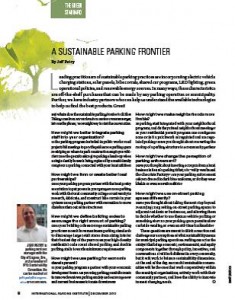Leading practitioners of sustainable parking practices are incorporating electric vehicle charging stations, solar panels, bike corrals, shared car programs, LED lighting, green operational policies, and renewable energy sources. In many ways, these characteristics are off-the-shelf purchases that can be made by any parking operation or municipality. Further, we have industry partners who can help us understand the available technologies to help us find the best products. Great!
But what’s does the sustainable parking frontier look like? Taking a cue from Harvard Business Review’s Warren Berger, let’s use the phrase, “How might we,” to start the conversation.
How might we better integrate parking staff into your organization?
Is the parking program included in public works’ road projects bid meetings to provide guidance on parking space re-striping or where to park construction employee vehicles? Does the permits office give parking a heads-up when a single-family house is being replaced by a multi-family complex? Is parking connected with your local utilities?
How might we form or create better local partnerships?
Does your parking program partner with the local poetry association to put poems in your garages? Does parking work with the local community college or university to research, fabricate, and construct bike corrals in your system? Does parking partner with recreation to move skateboarders out of its structures?
How might we define building codes to encourage the right amount of parking?
Does your building code encourage sustainable parking practices? Does it have maximum parking standards to discourage large retail stores from sizing lots for their busiest day of the year? Does your high-density residential code count shared parking and double parking stalls towards minimum requirements?
How might we use parking for economic development?
Is your parking program a partner with your economic development team? Are you using parking permit discounts to remove downtown parking anxiety and encourage new and current businesses to locate downtown?
How might we make neighborhoods more livable?
Is parking staff integrated with your neighborhood programs, and do they attend neighborhood meetings? Is your residential permit program one contiguous zone or is it a patchwork of regulated and un-regulated parking? Have you thought about converting the rooftop of a parking structure to a community garden?
How might we change the perception of parking enforcement?
Have you thought about inserting a coupon from a local business in lieu of a parking ticket, a la “Willy Wonka and the Chocolate Factory?” Are your parking enforcement officers dressed in dark blue uniforms, or do they wear khakis or even Hawaiian shirts?
How might we use on-street parking spaces differently?
Have you thought about taking the next step beyond PARK(ing) Day, selling on-street parking spaces to adjacent residents or businesses, and allowing them to decide whether to use them as vehicle parking or something else? Do your parking space permits allow curbside vending or even an old-time bookmobile?
These questions are meant to illicit a reaction and challenge our assumptions of what sustainability means for municipal parking operations. Parking can act as the catalyst that brings economic, environmental, and equity components together through policy, incentives, and conversations. It will look different in every community, but it will work to balance sustainability dimensions. At the end of the day, successful sustainable communities will be the ones that work cooperatively within the municipal organizations, actively work with their community partners, and have the ability to innovate to meet changing needs.
Jeff Petry is parking services manager with the City of Eugene, Ore., and a member of IPI’s Sustainability Committee. He can be reached at jeff.t.petry@ci.eugene.or.us or 541.682.5079
TPP-2012-12-A Sustainable Parking Frontier

